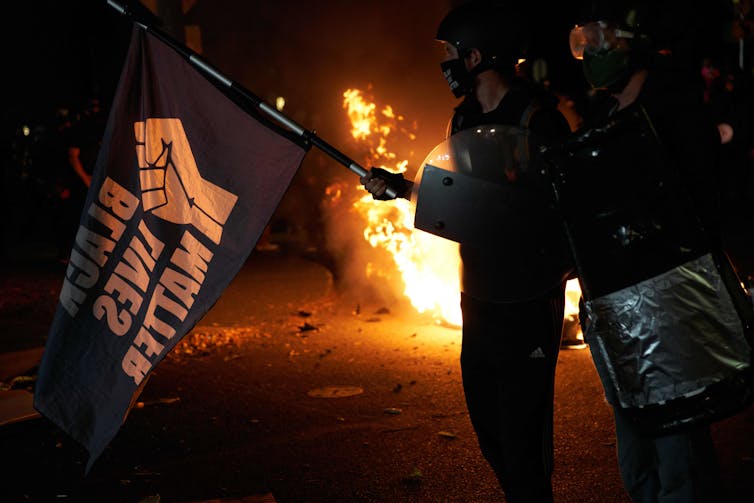David Stebenne, The Ohio State University
In this yr’s presidential election, phrases corresponding to “law and order” and “the silent majority” have been heard pretty usually from Donald Trump and a few of his supporters.
Those phrases hark again to an earlier presidential election, which took place in 1968. That one was a three-way affair involving former Vice President Richard Nixon, a Republican; incumbent Vice President Hubert Humphrey, a Democrat; and the third-party candidacy of a Southern segregationist, Alabama Gov. George Wallace.
As in 2020, the presidential election in 1968 occurred amid city unrest, rising violent crime, racial pressure, clashes between protesters and the police, and a excessive diploma of political polarization.
Despite these parallels, what actually stands out when one looks again to the 1968 election and compares it with this yr’s are the variations, not the similarities.

Centrist alignment
Although the occasions of 1968 such as urban riots, Martin Luther King Jr.‘s assassination, and the intense fighting in Vietnam had been polarizing, the 2 main events stood a lot nearer collectively on most points than they do now.
In 1968, the Democrats as a complete had been a extra centrist social gathering, whose ranks included a lot of conservative white Southerners in Congress in addition to in state and native workplaces. These Dixiecrats, as they had been recognized, tended to counterbalance the affect of the social gathering’s Northern liberals.
The Republican Party was additionally markedly extra centrist then, with a lot of reasonably conservative voters and lawmakers who restrained the GOP’s so-called “movement conservative” wing.
The far more centrist orientation of the two-party system, then, can be seen within the presidential candidates the Democrats and the Republicans selected in 1968. Both had been quintessentially institution figures.

The Democratic candidate, Hubert Humphrey, was in most respects a conventional New Deal liberal, the type of FDR-inspired, pro-union, anti-Communist middle leftist whose formative political expertise was the Great Depression.
GOP candidate Richard Nixon was greatest recognized for having served because the No. 2 man within the reasonably conservative Eisenhower administration. Although considerably different, these mainstream New Deal liberal and Eisenhower Republican viewpoints had been nonetheless nearer to one another than the types of liberalism and conservatism which can be dominant within the Democratic and Republican events in the present day.
The impartial candidate that yr, George Wallace, was a disruptive and polarizing determine. He finally finished a distant third in the race as a result of his working mate, General Curtis LeMay, turned off voters together with his very hawkish rhetoric in regards to the Vietnam War.
But the Wallace candidacy did have an effect on the election, as a result of his reputation within the South (the place he received 5 states) raised the chance that no candidate would achieve an Electoral College majority, which might have thrown the election into the U.S. House of Representatives.
The Wallace candidacy additionally made a distinction by contributing to the continued erosion in support for the Democratic Party amongst white Southerners, a pattern that finally reworked American politics.
In 1968, although, Wallace’s important impact on the race was to attract votes that would have gone to Nixon, who consequently won with only a plurality – 43% – of the national popular vote.
This three-way type of contest and its penalties are very different from this yr’s presidential race, which is basically a two-person race.

Old appeals could not work
Some of a very powerful points in 1968 had been additionally profoundly different from these of in the present day.
That yr, sharply rising inflation and the Vietnam War had been among the many most influential elements in deciding the result. That’s in marked distinction to 2020, when inflation is very low and no overseas coverage subject has something like the burden that Vietnam did in 1968.
And a number of the main points in 2020, such because the coronavirus pandemic, local weather change, well being care, excessive unemployment, immigration, commerce and the decline of the middle class (which hadn’t yet happened in 1968), had been absent 52 years in the past.
Even 2020’s protests in opposition to racial inequality and police brutality, in some methods much like those in 1968, are additionally different as a result of at the moment the main target was on resistance to the previous Jim Crow segregation system, not the less overtly visible systemic racism rooted in financial inequality and mass incarceration.
[Get our most insightful politics and election stories. Sign up for The Conversation’s Politics Weekly.]
Testing the identical strategy
If 1968 and 2020 are such different election years, why have phrases related to the primary tended to crop up in President Trump’s marketing campaign speeches?
Trump, who turned 22 in 1968, is sufficiently old to recollect the 1968 presidential race, which was the primary one through which he might vote. He little question additionally remembers the enchantment of Nixon’s “law and order” and “silent majority” themes amongst working-class and lower-middle-class white voters within the outer boroughs of New York City, the place he grew up. Although lots of these voters had been traditionally extra oriented towards voting for Democrats, rising crime and urban rioting increased fears of Black people among those kinds of voters. Nixon’s code phrases helped to drive them toward voting for Republicans.
Trump seems to be making an attempt to make use of that very same strategy this time, but given how different situations are in 2020 than they had been in 1968, it’s not clear that Trump’s techniques may have something like the traction they did when Nixon used them.
David Stebenne, Professor of History and Law Faculty, The Ohio State University
This article is republished from The Conversation below a Creative Commons license. Read the original article.







